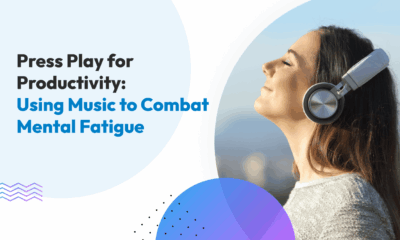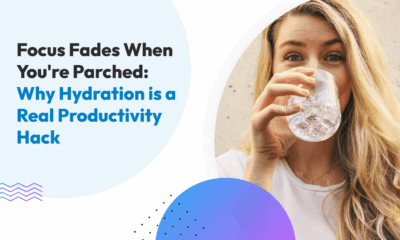Science Says
You’re Not Lazy — A Massive Study Just Revealed Why Exercise Feels Impossible
“Just exercise more and you’ll feel better!”
I f*cking hate that advice.
If you’re running a business and barely managing to keep your head above water, this probably makes you want to throw something. Or maybe you’ve tried, it worked for a bit, until it didn’t. Let’s talk about when everything feels like you’re pushing through quicksand. The last thing you need is someone chirping about how a morning jog will fix everything. Or worse, how you should be up at 5 AM, crushing a workout before your “competition wakes up.”
It turns out, there’s reason to be frustrated with that advice, and no, it’s not laziness. A massive 25-year study following 3,499 Americans just revealed something that challenges this entire narrative. As someone who’s been through the depression-exercise struggle myself, I had to dig into what they found.
Note: This article is for informational purposes only and isn’t medical advice. Always consult your healthcare provider before making changes to your mental health care or exercise routines.

Depression May Not Be What You Think
When I moved to San Diego in 2013 (my dream city!), I fell into one of the deepest depressions of my life. I was finally in paradise, right? But there I was, unable to understand why everything felt impossible when I’d literally achieved a major life goal.
The thing is, I wasn’t obviously “sad.” I was just… stuck.
This 25-year study, published in Mental Health and Physical Activity, opened with something crucial: depression is incredibly diverse. The researchers emphasized that “Depression is highly heterogeneous, as two persons with clinically significant DSx can present without a single shared symptom.”
The study used the Center for Epidemiological Studies-Depression (CES-D) scale, which captures a massive range of symptoms. In fact, it explains that Depression is “a continuum from relatively common forms of distress to clinical disorder.” That means everything from feeling lonely to restless sleep to that crushing sense that “everything is an effort.” For me? It was realizing I hadn’t left my house in a full week. Thank you, food delivery, for enabling that particular spiral.
Depression might look like crying spells for one person. For another? It’s chronic exhaustion, feeling like everything takes 10x more effort than it should, or that nagging sense that people don’t really like you. The researchers found this diversity means we often miss the signs because we’re looking for obvious sadness.
This hit home because I’ve seen so many entrepreneurs dismiss their symptoms. They think they are not “sad enough” to be suffering from a full-on disorder. They’re just tired. Or irritable. Or finding that everything feels like pushing a boulder uphill. Sound familiar? None of these are that uncommon in me or many of my clients.
How Life Circumstances Shape Everything
The researchers looked at how our changing life circumstances affect both mood and movement over 25 years. What they found surprised me.
Social connections are literally movement medicine. The study confirmed that “frequency of social contact is positively and significantly associated with physical activity.” They found that people with more social contact moved more, regardless of their depression symptoms. It wasn’t that social connection necessarily prevented depression, which then led to more movement. The social connection itself was directly linked to more physical activity.
During that week I didn’t leave my house in San Diego, I was also completely isolated. New city, no local friends yet, just me and my laptop. No wonder movement felt impossible.
Money stress hits your mood, but not your movement directly. Financial problems were linked to more depression symptoms but, surprisingly, didn’t directly reduce physical activity in the study. The researchers suggest that while financial stress significantly impacts mood, the main barrier to movement isn’t the cost of a gym membership but the mood changes that financial stress creates. Though let’s be honest, when you’re stressed about making rent, that membership might still be the first thing to go.
Health problems create vicious cycles. The study found that activity limitations (like chronic pain or mobility issues) were associated with both increased depression symptoms AND decreased physical activity. Ignore that nagging back pain or chronic fatigue at your own risk—it can spiral fast, creating a negative feedback loop that’s hard to break.

The Finding That Flipped Everything I Thought I Knew
Here’s where the research gets really interesting. After tracking these 3,499 adults for 25 years, controlling for genetics, childhood experiences, and life circumstances, researchers found:
Depression symptoms predicted lower physical activity in the future, but being more physically active didn’t significantly protect against future depression.
I had to read that several times.
The study showed that at any given moment, depressed people were less active (ok, no surprise). But over time? Depression led to less future activity, while current activity levels didn’t prevent future depression. The influence mainly flows from depression → future activity levels, not the other way around.
This hit me like a ton of bricks because it explained so much. I had joined a CrossFit gym when I first moved to San Diego. I was going regularly while apartment hunting, feeling productive and accomplished. But once I settled into my new place and that constant pressure and goal-oriented period ended? I suddenly just could NOT go.
It wasn’t laziness. It wasn’t a lack of willpower. The depression had crept in and made movement genuinely harder.
Why This Actually Makes Sense (And What Still Helps)
Before you throw your running shoes in the trash and cancel your gym membership, here’s the crucial part: the study absolutely confirms that exercise helps mood in the moment. Physical activity showed strong cross-sectional associations with better mood at every time point measured.
What the research reveals is more nuanced: exercise provides immediate mood benefits and is absolutely worth doing, but it’s not a long-term prevention strategy for depression. The relationship mainly flows from depression to future activity levels, not the other way around.
For those of us who often work alone and manage high stress (not that running a business is stressful 🙃), this is actually liberating. If you’re struggling to maintain your workout routine right now, it’s not a character flaw. It may be depression (remember, it’s a scale!). Landing anywhere on the scale drains motivation and energy, making it genuinely harder to stay active.
So what actually works? Well, meeting yourself where you are.
I decided to see a therapist during that moment in San Diego and she gave me the tiniest assignment when I was at my lowest: just sit outside in the grass. That’s it. Not walk. Not exercise. Just… sit outside.
That tiny act snowballed way faster than I expected. Sitting outside led to feeling like taking a little walk. The walk made me remember I had a body that could move. Within weeks, I was back to regular movement (and the CrossFit gym!). But it started with addressing depression, not forcing exercise.
The study confirms this approach works. It included everyday activities like gardening, walking, even moderate housework in their definition of physical activity. Intensity mattered far less than consistency. Any movement beats no movement, even if that movement is just 10 steps to go sit outside.

There Is No “Right Age”
The researchers tested whether certain ages made the depression-activity relationship stronger or weaker. Are your 20s the critical time to dig into this? Your 40s?
Their finding: The depression-activity relationship stayed exactly the same whether people were 25 or 65. After accounting for all those life factors, there’s no magical window of opportunity. No “critical period” where it’s easier to break the cycle.
It’s easy as we age to wonder if we’re stuck and repeat phrases like “that’s just the way I am” or “have always been”. It’s all too easy to say something like that so many times we believe it. It turns out, that’s complete BS. The best time to start taking care of yourself is literally right now, wherever you are in life or business.
The Real Bottom Line
So, is exercise useful? Certainly, but we need to stop treating exercise like a magic bullet and start seeing mental health as the complex, multifaceted thing it is. Sometimes you might need therapy. Sometimes medication. Sometimes, I just sit in the grass. And just maybe, all of the above.
Movement can help too. But we need to listen to the signs and not just throw solutions at our mental health. It’s okay to try exercise, of course. But if that’s not working for you, like it wasn’t working for me when I’d just moved to San Diego, when it just wasn’t an option, maybe something else is a better solution…like therapy.
It’s always best to consult a professional when it comes to mental health instead of just cycling through Instagram wellness advice. Building a sustainable business means building a sustainable YOU. And that means being realistic about what you’re dealing with and getting the support you actually need.
Your optimal movement time might change as your business evolves, and that’s completely fine. I used to work out at noon when I primarily ran a service-based business, and it was perfect. Now that I’m primarily coaching and creating content, I need that morning “me time” before I start giving to others all day. Neither is right or wrong, it’s about what works for YOUR life right now.
So here’s my question: What phase are you in right now? Are you forcing yourself to follow rigid exercise rules while your mental health needs attention? Or beating yourself up for not moving “enough” when you’re genuinely struggling?
Because if you’re sitting there feeling guilty about not being “productive enough” with your exercise routine during a rough patch, you’re focusing on the wrong thing. Your brain knows what it needs. Maybe it’s time we started listening.
P.S. If you’re curious about working WITH your natural energy rhythms instead of against them, I dive deep into recognizing your brain’s “seasons” in another article. Because sometimes the answer isn’t pushing through, it’s knowing when to push and when to rest.
Sources & Notes
Limitations of the Study
While this study offers valuable insights into the relationship between depression symptoms and physical activity, it’s important to recognize several limitations that shape how the findings should be interpreted.
First, both depression symptoms and physical activity were measured using self-reported surveys. This means participants described their own moods and activity levels, which can sometimes lead to over- or underestimation. People may not always remember accurately, or they may answer in ways they think are expected.
Additionally, the physical activity questions focused on how often people engaged in activities like walking, gardening, or sports, but did not capture how intense or vigorous those activities were. As a result, the study cannot say whether more strenuous exercise offers different benefits compared to lighter movement.
Another limitation is the timing of the data collection. Participants were surveyed every few years, with gaps ranging from three to nine years between check-ins. This long interval means the study could miss short-term changes or the immediate effects of exercise on mood, which other research suggests can happen within days or weeks. The study’s design is best suited for understanding long-term patterns, not the rapid ups and downs that many people experience.
The analysis also could not examine whether the relationships between depression and activity were different for men versus women, or for people of different racial or ethnic backgrounds. The statistical approach used was designed to control for stable personal factors, but this meant it could not test for differences based on gender, race, or other unchanging characteristics.
Furthermore, the study did not include genetic data or objective measures of activity, such as wearable fitness trackers, which could have provided a more detailed picture of how movement and mood interact.
Finally, while the study adjusted for many life changes—like shifts in social life, health, or finances—it cannot account for every possible outside influence. Major life events or unique personal circumstances may still have played a role in participants’ experiences.
About the Research
Soli Dubash, The interplay of depression symptoms and physical activity: Bidirectional insights from 25-years of the Americans’ changing lives panel, Mental Health and Physical Activity, Volume 26, 2024, 100599, ISSN 1755-2966, https://doi.org/10.1016/j.mhpa.2024.100599. (https://www.sciencedirect.com/science/article/pii/S1755296624000255)
Abstract:
Background
Depression symptomology (DSx) and insufficient Physical Activity (PA) are among the leading causes of illness, and major contributors to global public health burden. Reviews and meta-analyses indicate that DSx and PA cause each other, yet most studies conducted use data and analyses which cannot specify their bidirectional associations across the life course.
Method
The present study estimates dynamic panel models with fixed effects through structural equation models with full-information maximum likelihood estimation (ML-SEM) based on 5 waves (1986–2011) of the Americans’ Changing Lives (ACL) panel. This is a nationally representative probability sample of 3499 non-institutionalized U.S. adults ages 25 and older in 1986. Respondents participated in an average of 3.29 waves, with 67.84% participating in at least 3 waves, and 27.26% participating in all 5 waves. Models adjust for age, partner status, social integration, activity limitations, and serious financial problems. Data are available from the ICPSR (4690).
Results
Estimates from ML-SEM reveal negative and significant bidirectional cross-sectional associations between DSx and PA. Models also indicate a negative and significant cross-lagged association from DSx to PA, but not from cross-lagged PA to DSx. On both sides, earlier levels are significantly associated with future levels of PA and DSx.
Conclusions
This study is the first to use a causal inference technique which adjusts for all time-invariant confounders while modelling the bidirectional linkages between depression symptoms and physical activity over 25-years of adulthood. It supports literature showing a consistent cross-sectional relationship, and advances understanding on how DSx earlier in the adult life course may influence PA as people age.












